Monstera plants have become a popular household plant in recent years due to their attractive, large leaves and ability to thrive in most indoor conditions. They are a vibrant, low-maintenance plant that is often found in homes and gardens. With their showy, glossy foliage and unique split leaves, Monsteras can add an exotic feel to any room or outdoor living area.
Here you will come to know what are the ideal environmental conditions you should provide your Monstera plant, so that you can get ideal growth. This article aims to provide a comprehensive guide that will help identify the source of the problem and give advice on how to resolve it. This easy-to-follow guide will take you step by step through the diagnosis process, providing helpful tips and tricks along the way.
Origin
Native to Mexico and Central America, Monstera can grow up to 20 feet tall and thrive in warm, humid climates. The name is derived from the Latin word for “Monstrous” due to its large leaves, which can grow up to three feet wide. The first mention of these plants dates back to 1696 when European explorer Francis Drake observed the plant being cultivated by the natives of Panama.
As a species these are vining herbaceous epiphytes which rely on trees or other supports for stability and reach heights up to 60 feet in optimal conditions. They have large, leathery leaves with deep lobes that give them their distinctive look that makes them so popular as ornamental plants. Their fruit is edible and has a mild flavor similar to pineapple when ripe.
Biological History
Monstera plants are one of the most popular houseplants in recent years, and for good reason. These beautiful tropical plants can be found in the jungles of Central and South America, where they have been growing since ancient times. The plant belongs to the Araceae family, which includes over 3,500 different species of aroids. They are known for their large lobed leaves that can range from dark green to lighter shades with white or yellow variegation depending on variety.
The genus Monstera was named by Carl Linnaeus in 1763. It is believed that this plant has been around since prehistoric times and is native to tropical regions such as Mexico and Colombia. In its natural environment, it is an epiphyte – meaning it grows on other trees instead of directly on the ground like other plants – so it needs support to grow properly. Monstera plants have been traditionally used for food and medicinal purposes in their native region.
Traits
With their large, glossy leaves and interesting shapes, Monsteras make excellent houseplants for any home. Not only do they look great, but there are many traits that make them perfect for even novice growers.
One of the most attractive traits is their hardiness. They can tolerate a range of temperatures and humidity levels, as well as low light conditions making them easy to care for in most homes. Additionally, they require minimal pruning or maintenance once established and can be watered every 7-10 days depending on the season. Another trait that makes your plants so desirable is their ability to purify air in your home.
Monstera Plants having Holes in Leaves
Monstera plants are a popular houseplant with distinctive, large, heart-shaped leaves that feature holes and tears. But why do these tears and rips in the leaves occur?
It is an integral part of how the plant grows, allowing it to reach for more light and expand its overall size.
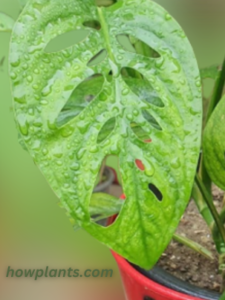
First off, it helps the plant reach for more light as it matures. As the plant ages, its stem grows longer and thicker which can cause tension on the leaf veins. To help relieve this tension, these ‘windows’ or ‘swiss cheese’ shaped holes form to prevent further damage from occurring to the leaves which could be fatal if not relieved. The holes allow light to penetrate deeper into wider foliage while also increasing air circulation around all parts of the leaf surface.
Guidelines To Care My Monstera Plants
Light Requirements
Monstera plants require moderate sunlight, but can tolerate low-light conditions. It is best to place the plant in a location where it will receive bright indirect light.
Climate required
It’s important to understand the climate requirements for Monstera plants before bringing one into your home. As they are native to Central America and thrive in warm and humid climates. The ideal temperature range for Monsteras is between 65-85°F (18-29°C), although temperatures as low as 55°F (13°C) will not kill the plant. Humidity should be kept around 50%, ideally higher during warmer months or when temperatures rise over 85°F (29°C). Stems also require plenty of bright indirect light to keep their leaves vibrant and healthy.
Humidity of monstera plants
For those looking to grow a Monstera indoors, it is important to understand the impact of humidity on their growth. Humidity plays an important role in health, helping them maintain turgidity and allowing for efficient uptake of nutrients from the soil. In general, healthy Monsteras prefer higher levels of humidity, with an ideal range between 60-80%. Too much or too little could affect their growth and cause leaves to brown or droop. To increase humidity around your plant at home, you can mist it frequently with water or use a room humidifier. Additionally, grouping multiple plants together will help create a more suitable environment for them as well.
Water requirements
Watering Monsteras appropriately takes some trial and error as their needs will change depending on the season and size of the plant. During spring and summer, when growth is more active, water it once a week or every other week with distilled water or rainwater if possible, as tap water often contains chemicals which can discolor leaves or cause leaf drop. During fall and winter months when growth slows down considerably you should cut back watering significantly; watering once every two weeks should suffice during this period.
Ideal temperature
The optimal temperature range for Monstera plants is between 65 and 80 degrees Fahrenheit. In temperatures above 90 degrees Fahrenheit, the leaves may become discolored or scorched due to intense heat exposure. On the other hand, during extreme cold weather conditions when temperatures dip below 50 degrees Fahrenheit, this can cause frostbite on your Monstera’s leaves and stem. Therefore it is best to keep the temperature around your plant within its preferred range in order to prevent any damage from occurring.
Soil composition and pH requirements
For a Monstera plant to reach its full potential, there are certain soil composition and pH requirements that need to be met. The ideal soil for a Monstera should be light, well-draining and rich in organic matter. A combination of peat moss or coco coir mixed with perlite, pumice or bark chips provides the perfect balance for the growing roots. It is also important that this mixture is kept on the slightly acidic side with a pH between 5-6.5 as this will allow for optimal nutrient uptake by the roots. Nutrient deficiencies can cause slow growth or yellowing of leaves which indicate it’s time to adjust your soil composition and/or pH levels to get back on track!
When to repot Monstera Plants?
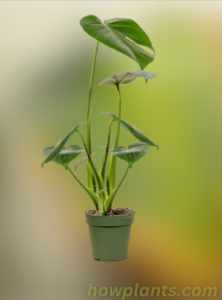
To keep your plant healthy and thriving, it’s important to understand the signs that indicate it’s time for a bigger pot. Repotting is not something that needs doing on a regular basis; rather, it should only take place every two or three years. It’s usually best done during the springtime when the weather starts warming up as this ensures plenty of growing season for your plant after being transplanted into a new pot. One indication that your Monstera is ready for repotting is if its roots are visible at the bottom or on top of the soil. If roots are emerging through drainage holes in the pot as well, then it’s likely time to move up in size. You should also take note if there is any yellowing or wilting of leaves that don’t recover with watering; this indicates that your plant needs more space for its root system to expand further and absorb more nutrients from fresh soil.
Monstera without having Holes
If you have ever seen a Monstera, then you know that the large leaves are full of beautiful holes. But did you know that Monstera can exist without any such holes? It is true – Monstera without holes do exist! In fact, these plants are just as attractive and hardy as their hole-filled counterparts.
Monsteras without holes are often called “Lacera” or “Split Leaf Philodendron” due to the leaflets being split into various shapes. While it is believed this mutation occurred naturally in nature, some florists and nurseries have managed to create new varieties of this plant on purpose by breeding them together. This process is done carefully so as not to damage the original genes of the plant. The Monstera without holes has a very striking appearance with its dark green color and beautiful leaf patterns. The plant can grow up to 5 feet tall, perfect for those looking for a large canopy of shade.
Problems Associated with Monstera Plants
There are a few issues you should be aware of before bringing one of these plants into your homes.
One of the most common problems associated is improper watering. Too much water can cause root rot, whereas too little will lead to wilting and yellowing leaves. It’s important to find the balance between too much and not enough water to ensure your Monstera stays healthy and vibrant. Additionally, if you’re keeping your Monstera indoors you’ll need to provide it with plenty of bright indirect light in order for it to flourish properly over time. If there’s not enough light, its leaves will start to turn yellow and fall off prematurely.
Mechanical damages that causes Tears and Rips in Monstera Leaves
Monstera plants are known for their lush foliage and unique leaf structure. However, due to their sensitive nature, they can be prone to mechanical damage. Mechanical damage is perhaps the most common problem encountered by Monstera owners, caused by anything from rough handling or excessive pruning to nutrient deficiencies or heavy wind. Fortunately, there are steps that can be taken to both prevent and treat any mechanical damage your Monstera may sustain.
The first step in preventing mechanical damage is ensuring proper potting conditions; make sure your Monstera has access to plenty of soil moisture and nutrients including zinc, phosphorus, and magnesium. Fertilizing regularly with a balanced fertilizer will also help promote healthy growth so the plant’s cells don’t become brittle from lack of nutrition.
For plants that have mechanical damage, you can try to repair the damage by pruning out the damaged tissue. If the damage is more severe than you’d like to attempt repairing, you can simply remove the plant’s lower leaves and trunk and replant it in a new pot.How dry wind affects Monstera Plants?
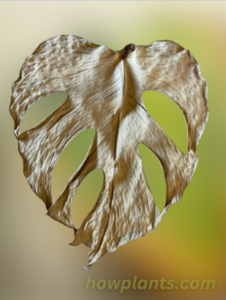
Monstera plants are sensitive to the environment, including the dry wind. Dry winds can have a negative effect on these popular indoor plants, causing them to become dry and brittle. To keep your plant healthy and happy, it is important to understand how dry winds can affect them and what you can do about it.
Dry wind affects Monsteras by drying out their leaves faster than normal; this causes leaves to become crispy or cracked. The dryness of the air also makes it difficult for these plants to take up water from their soil, leading them to become dehydrated and wilted over time. It is important to protect it from strong winds as much as possible; if this isn’t possible try placing it near a wall that will act as a windbreak.Why brown rips develop in Monstera Plants?

What happens when brown rips appear on the leaves? Brown rips are an unfortunately common occurrence, but luckily they don’t signal that your Monstera is doomed. Understanding why these marks appear can help you prevent further damage to your plant, so let’s take a closer look at why brown rips develop in Monsteras.
The main cause of brown rips is too much direct sunlight or extreme heat. When the sun is too intense for too long, it can cause the leaves to become scorched and fragile. This makes them prone to tearing or ripping easily when brushed against something else or touched by hand.Monstera Stem damage
Stem damage is often caused by environmental stressors such as too much direct sunlight or irregular watering patterns. Additionally, pests such as mealybugs or scale insects can cause discoloration on the stem of the plant or wilting leaves that could indicate stem damage. Lastly, diseases such as botrytis blight can also cause serious damage to the stems if left untreated.
How damaged Leaves of Monstera Plants will be treated?
When these leaves become damaged, it can be upsetting for owners who have invested so much care and attention into their plant. Fortunately, there are several methods available to treat damaged Monstera leaves and get them back to looking healthy again.
The first step is to identify why the damage occurred. If it is due to pests or over-watering, appropriate action needs to be taken before attempting any treatment on the leaves themselves. Once you have determined the cause of damage and rectified it if possible, it’s time to move on and assess how far along the damage is on each leaf.
Bending, Drooping and Wilting of Monstera Stem
Unfortunately, it’s not uncommon for these plants to experience dropping or bending of the leaves. If you notice that stems of your Monstera stems are bending and becoming wilt it is an indication that your Monstera is not receiving an appropriate amount of water. So if you notice wilt stems give a proper amount of water so that it will get normalized. Sometimes it bends because it needs mechanical support. So first you have to figure out the exact problem. After that, go for the solution that whether it requires mechanical support or water deficiency should be fulfilled. There are a few possible reasons why this might be happening, which include too much or too little sunlight, improper watering routines, pests infestations, and temperature fluctuations. Fortunately, there are steps that can be taken to remedy the situation and get your Monstera back on track.

Firstly, if your plant is receiving more sunlight than it needs then find somewhere else for it to live where it gets less direct light exposure. If you think it’s the lack of sunlight that’s causing the drooping then move the plant closer to a window or remove some curtains so that enough light reaches.
Monstera Leaves Yellowing

Yellowing of monstera leaves occurs when the plant is overwatered. If leaves are getting yellow then the best solution is to repot the plant into new soil. To prevent yellowing of leaves, always avoid reporting. Ideally these plants are reported on the 7th day. Only water the plant when at least three layers of the soil have been dried out. Too much water can cause root rot, whereas too little will lead to wilting and yellowing leaves. It’s important to find the balance between too much and not enough water to ensure your Monstera stays healthy and vibrant. Additionally, if you’re keeping it indoors you’ll need to provide it with plenty of bright indirect light in order for it to flourish properly over time. If there’s not enough light, its leaves will start to turn yellow and fall off prematurely.
Yellow and Brown spots on the Surface of Leaves: Reason
In order to understand why these issues arise and how to combat them, it is important to know what causes Monstera leaf spotting.
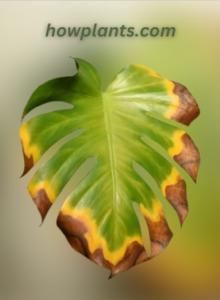
The main cause of yellow and brown spotting on monstera leaves is typically too much direct sunlight. Although this plant loves bright light and indirect sun, if exposed to intense direct sun they can become burned leading to discoloration and spotting on the surface of its leaves. Other possible causes include over-fertilization or not enough water which both lead to nutrient deficiencies resulting in discoloration spots on their foliage.
Why edges of Monstera Leaves become brown?: Causes and Cures

Brown edges on monstera leaves can be concerning for indoor plant lovers. The leaves of this beautiful, easy care, tropical houseplant can become unattractive when the edges turn brown and crispy. The most likely cause of browning is environmental stress due to a lack of water or too much direct sunlight. Brown edges on monstera are also a sign that the plant has been overwatered – either from poor drainage or from being watered too often. To help prevent further damage, use lukewarm water when watering and make sure to never let the soil dry out completely between watering. If possible, move your plant away from any windows as it does not tolerate direct sunlight well.
Pest Attacks: Changes in Monstera Leaves Color
As part of the natural life cycle of a plant, the color of its leaves tend to change over time. However, one major factor that can cause changes in the appearance of a Monstera’s leaf color is pest attacks.
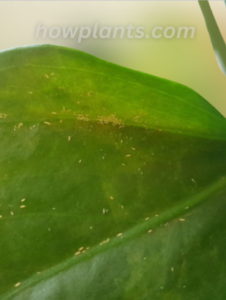
When pests such as aphids or mealybugs attack Monstera plants, they feed off the sap from its leaves and stems. This causes discoloration on its foliage as a result of decreased chlorophyll production in the leaf cells due to lack of nutrients from sap loss. The affected leaves will typically turn yellowish or brown in areas where these pests have been feeding on them. Furthermore, these pests also secrete a sticky substance called honeydew which can further damage the plant by promoting fungal growth and disease development on its foliage.
Snapped Stem of Monstera Plants: Causes and Treatments
Snapped stem syndrome is a condition when one or more of the stems snap off near its base due to wind damage or a heavy pot. If your Monstera has suffered from snapped stem syndrome there are treatments available to help it recover.
Snapped stem syndrome is caused when the soil around the roots becomes too dry or waterlogged for prolonged periods of time. The sudden change in moisture levels causes the plant’s root system to become weak and unable to support itself correctly leading to snapping of its stems. The best way to prevent this is by ensuring your monstera remains properly hydrated with well-aerated soil and adequate but not excessive watering habits throughout its growing season.
Why Leaves of some Monstera remains Small? How to make them Bigger
While most Monstera plants will produce larger leaves as they age, some can remain small and stunted over time. This can be caused by a few different environmental factors, such as too little light or incorrect watering techniques. Well, there are steps you can take to ensure your Monstera grows healthy and vibrant foliage.
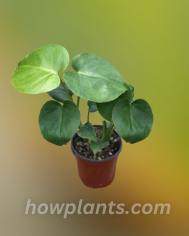
When it comes to lighting, make sure it is placed in an area that receives plenty of bright indirect sunlight throughout the day. Additionally, be aware of the temperature that your plant lives in; temperatures below 60°F may stunt growth and keep leaves smaller than normal. It’s also important to water your Monstera regularly but not excessively; too much moisture will suffocate the roots of the plant and lead to stunted growth.
Splitting Monstera Leaves
It is an easy way for plant enthusiasts to propagate their beloved Monstera plants. To propagate your own, all you need is a few basic gardening supplies.
The process of splitting leaves is simple and doesn’t require any advanced gardening skills. Start by gathering up your supplies: potting soil, clean scissors, plastic pots or containers, and rooting hormone (optional). Cut the leaf off at its base with the scissors – make sure it’s just above the nodule where roots can form. Plant it in the potting soil and keep moist until new shoots appear and roots begin to grow – this can take anywhere from two weeks to several months depending on the conditions of your environment.
Why do Monstera Leaves split. What to do if they are not showing Splitting?
Many people wonder why these plants display this unique feature and what they should do if the leaves of their Monstera aren’t splitting. The reason behind the split leaf is because it helps the plant get more light in its native habitat, and it also allows for more air circulation around each leaf. When grown indoors, however, too little light can prevent the splits from forming. To encourage healthy growth and ensure that your Monstera displays its signature look, provide it with adequate sunlight or artificial grow lights and make sure to avoid overwatering as this can stunt development. With plenty of bright light and moisture in moderation, you should begin to see splitting in your Monstera’s leaves within a few weeks.
Split Leaf Philodendron
Monstera plants are often confused with split leaf philodendron, but these plants are entirely different, varying in their size, shape and pattern of splits.
Conclusion
Monstera leaves are a popular houseplant choice due to their distinctive split-leaf shape. They are a favorite among houseplant lovers. Not only are these plants beautiful, but they also boast remarkable air-purifying abilities. They are very helpful in keeping the environment warm and also have the capability to absorb environmental pollutants and help in reducing air pollution. Thus it is an environmentally friendly plant. Its completely ripened fruit is the source of vitamins B and C and also provides protein. It is a beautiful plant whose presence will give you a feeling of warmth and beauty.
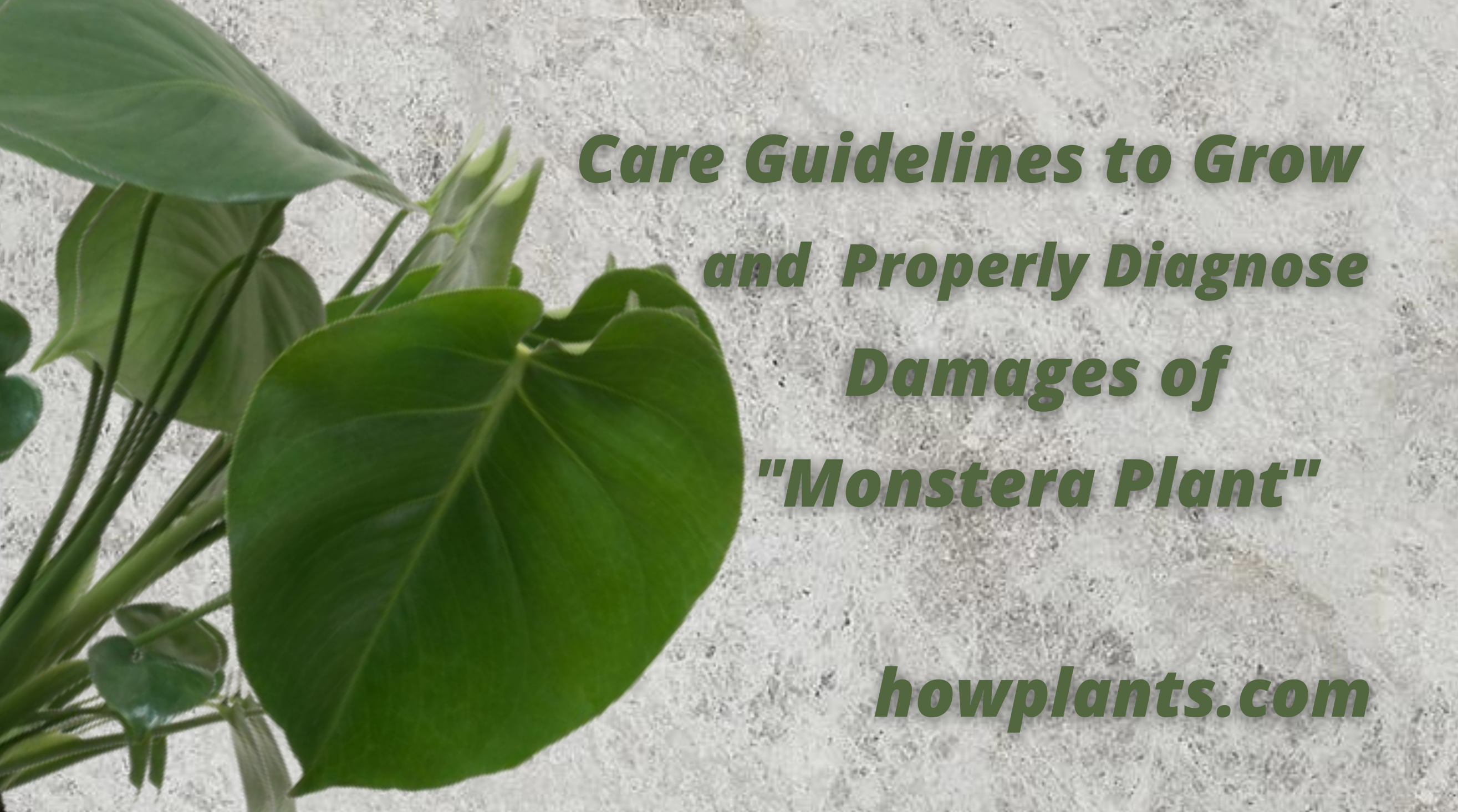
1 thought on “Monstera Plant: Best Care Guide, Information and Tips to Grow and Properly Diagnose Damages”